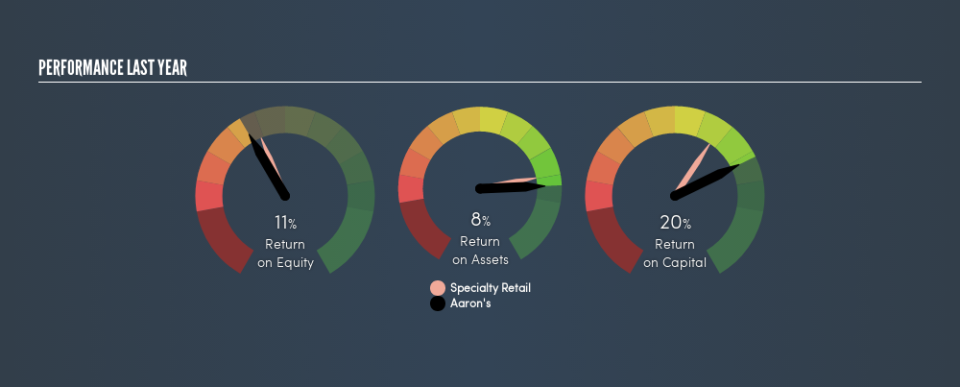Why Aaron’s, Inc.’s (NYSE:AAN) Return On Capital Employed Is Impressive

Today we are going to look at Aaron’s, Inc. (NYSE:AAN) to see whether it might be an attractive investment prospect. Specifically, we’re going to calculate its Return On Capital Employed (ROCE), in the hopes of getting some insight into the business.
Firstly, we’ll go over how we calculate ROCE. Then we’ll compare its ROCE to similar companies. Then we’ll determine how its current liabilities are affecting its ROCE.
What is Return On Capital Employed (ROCE)?
ROCE is a measure of a company’s yearly pre-tax profit (its return), relative to the capital employed in the business. All else being equal, a better business will have a higher ROCE. Overall, it is a valuable metric that has its flaws. Renowned investment researcher Michael Mauboussin has suggested that a high ROCE can indicate that ‘one dollar invested in the company generates value of more than one dollar’.
How Do You Calculate Return On Capital Employed?
Analysts use this formula to calculate return on capital employed:
Return on Capital Employed = Earnings Before Interest and Tax (EBIT) ÷ (Total Assets – Current Liabilities)
Or for Aaron’s:
0.20 = US$482m ÷ (US$2.8b – US$377m) (Based on the trailing twelve months to December 2018.)
So, Aaron’s has an ROCE of 20%.
Check out our latest analysis for Aaron’s
Is Aaron’s’s ROCE Good?
One way to assess ROCE is to compare similar companies. Using our data, we find that Aaron’s’s ROCE is meaningfully better than the 13% average in the Specialty Retail industry. I think that’s good to see, since it implies the company is better than other companies at making the most of its capital. Separate from Aaron’s’s performance relative to its industry, its ROCE in absolute terms looks satisfactory, and it may be worth researching in more depth.
When considering this metric, keep in mind that it is backwards looking, and not necessarily predictive. ROCE can be misleading for companies in cyclical industries, with returns looking impressive during the boom times, but very weak during the busts. ROCE is only a point-in-time measure. What happens in the future is pretty important for investors, so we have prepared a free report on analyst forecasts for Aaron’s.
How Aaron’s’s Current Liabilities Impact Its ROCE
Current liabilities include invoices, such as supplier payments, short-term debt, or a tax bill, that need to be paid within 12 months. Due to the way the ROCE equation works, having large bills due in the near term can make it look as though a company has less capital employed, and thus a higher ROCE than usual. To check the impact of this, we calculate if a company has high current liabilities relative to its total assets.
Aaron’s has total assets of US$2.8b and current liabilities of US$377m. As a result, its current liabilities are equal to approximately 13% of its total assets. Low current liabilities are not boosting the ROCE too much.
Our Take On Aaron’s’s ROCE
Overall, Aaron’s has a decent ROCE and could be worthy of further research. Of course you might be able to find a better stock than Aaron’s. So you may wish to see this free collection of other companies that have grown earnings strongly.
If you like to buy stocks alongside management, then you might just love this free list of companies. (Hint: insiders have been buying them).
We aim to bring you long-term focused research analysis driven by fundamental data. Note that our analysis may not factor in the latest price-sensitive company announcements or qualitative material.
If you spot an error that warrants correction, please contact the editor at editorial-team@simplywallst.com. This article by Simply Wall St is general in nature. It does not constitute a recommendation to buy or sell any stock, and does not take account of your objectives, or your financial situation. Simply Wall St has no position in the stocks mentioned. Thank you for reading.

